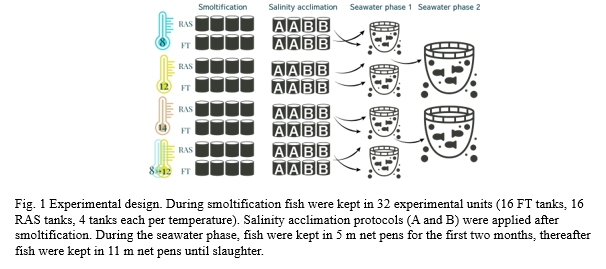EARLY REARING CONDITIONS AND THEIR INFLUENCE ON ATLANTIC SALMON Salmo salar PERFORMANCE LATER IN LIFE
Introduction
Atlantic salmon smolt production in Norway has been intensified over the past years and has led to concern about increasing prevalence of life-style disease s in cultured Atlantic salmon (Frisk et al. 2021) . Temperature and water salinity are critical rearing parameters that differ between smolt hatcheries (Kristensen et al. 2011) and directly affect Atlantic salmon physiology. While several studies have examined these factors in short-term experiments (Handeland et al. 1998 , Handeland et al. 2000) , there is limited documentation on how smolt rearing history changes long-term growth, welfare, and slaughter quality . In this study, we evaluated the short- and long-term effects of four temperature groups: 8°C, 12°C, 14°C, and a group with temperature increased from 8°C to 12°C. We hypothesized that lower rearing temperature in fresh water would result in better growth at sea. In addition, we evaluated the potential benefits of acclimatizing smolts to salinity prior to seawater transfer. All treatments were assessed in both flow-through (FT) and RAS systems.
Material and Methods
The experiment consisted of a smolt production phase, when treatment groups were established, followed by seawater grow-out until slaughter (Fig. 1). The first phase of the experiment was conducted simultaneously in flow-through and RAS systems at Nofima’s Research Station for Aquaculture in Sunndalsøra, Norway . A total of 4800 parr (10 g) were distributed across 32 rearing units and pit-tagged after reaching 20 g. All fish were exposed to a photoperiodic regime consisting of over 5 weeks of 12 hours of light and 12 hours of darkness, followed by 350 degree-days of continuous 24-hour light to induce smoltification. After smoltifica tion, water salinity was either increased directly to 32 ppt (A), or gradually over a three-week period (B). Thereafter, 2560 smolts were and stocked in net pens at a seawater facility for grow-out. During the seawater period, the fish were kept in a common garden design. Fish and water samples were collected multiple times throughout phase 1, and at the end of the seawater phase. The analysis of response variables included water quality characterization, growth, survival, and several morphological and lab-based welfare indicators (Noble et al. 2018).
Results and discussion
Throughout the experiment, the fish from the different treatments had low mortality and a seemingly good welfare status. During the freshwater phase , all groups developed typical smolt characteristics , indicated by an increased Na+, K+-ATPase (NKA) activity in gills, kidney, and intestine in response to 24 hours light underlining the importance of photoperiod for smolt development, irrespective of temperature. Even though the NKA development was similar in all groups, overall lower levels of NKA activity in fish held at 8°C and a less pronounced reduction in condition factor , suggest that these fish may have needed more time than the 350 degree-days to complete smoltification. Yet, serum analyses after seawater challenge tests before seawater transfer showed good and similar hypoosmoregulatory ability in all groups. Interestingly, there were distinct differences in water quality between FT and RAS systems, with an accumulation of major cations and CaCO3 seen in RAS, irrespective of temperature regime, over time. This finding can potentially explain differences seen in kidney NKA activity between FT and RAS.
Surprisingly, salmon from the 12°C and 14°C had a significantly higher thermal growth coefficient, and larger final body mass ( 4.4 vs 3.3 kg) than their conspecifics from the 8°C and 8-12°C groups. Also, the slaughter quality score was higher in these groups. Yet, there was a tendency for smaller hearts in the fish of the 12°C and 14°C groups at the end of the experiment, and it can be speculated if this could have compromised these fish in case of a disease outbreak or during strong stress exposure, however, no disease outbreak occurred, and all groups handled exposure to lice treatments equally well. D uring the seawater phase the fish experienced almost ideal growth conditions, with low stress and high-quality feed. Under favorable conditions, early rearing temperatures up to 14°C lead to faster production of high-quality salmon for consumption. However, potential effects on robustness should be investigated in future studies.
Ethical statement on animal welfare
The experiment was conducted following the EU legislation on animals in science and was approved by the Norwegian Food Safety Authority (ID#29982).
References
Frisk, M., Høyland, M., Zhang, L., Vindas, M. A., Øverli, Ø., & Johansen, I. B. (2020). Intensive smolt production is associated with deviating cardiac morphology in Atlantic salmon (Salmo salar L.). Aquaculture, 529, 735615.
Handeland, S. O., Berge, Å., Björnsson, B. T., & Stefansson, S. O. (1998). Effects of temperature and salinity on osmoregulation and growth of Atlantic salmon (Salmo salar L.) smolts in seawater. Aquaculture, 168(1-4), 289-302.
Handeland, S. O., Berge, Å., Björnsson, B. T., Lie, Ø., & Stefansson, S. O. (2000). Seawater adaptation by out-of-season Atlantic salmon (Salmo salar L.) smolts at different temperatures. Aquaculture, 181(3-4), 377-396.
Kristensen, T., Haugen, T. O., Rosten, T., Fjellheim, A., Åtland, Å., & Rosseland, B. O. (2012). Effects of production intensity and production strategies in commercial Atlantic salmon smolt (Salmo salar L.) production on subsequent performance in the early sea stage. Fish physiology and biochemistry, 38, 273-282.
Noble C, Gismervik K, Iversen MH, Kolarevic J, Nilsson J, Stien LH, Turnbull JF, AS N. Welfare Indicators for farmed Atlantic salmon: tools for assessing fish welfare.
